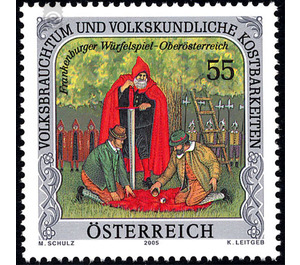traditions - Austria / II. Republic of Austria 2005 - 55 Euro Cent
Theme: Architecture
| Country | Austria / II. Republic of Austria |
| Issue Date | 2005 |
| Face Value | 55.00 |
| Edition Issued | 700,000 |
| Printing Type | combination printing |
| Stamp Type | Commemorative |
| Item Type | Stamp |
| Chronological Issue Number | 1886 |
| Chronological Chapter | OOS-OE2 |
| SID | 617500 |
| In 55 Wishlists | |
The turmoil and religious conflicts of the Thirty Years' War (1618-1648) did not stop at Upper Austria. In 1620, the Habsburgs pledged the land to the Bavarian Duke Maximilian I in exchange for the conquest of the largely Protestant Upper Austria that had fallen out. The ruler, brought up in strict Catholicism by the Jesuits, sent not only tax officials but also Catholic clergymen who were to destroy Protestantism in the sense of the Counter-Reformation. In 1625, for example, a new Catholic pastor was to take over the Protestant parish in Frankenburg, but that was too much for the citizens and peasants. They armed themselves, it came to a rebellion and they expelled the Catholic pastor. The castle Frankenburg was besieged by the angry mob for three days. The rebels abandoned the siege, as they were promised mercy if all involved in the uprising unarmed to Haushamerfeld. On May 15 at the Haushamerfeld between Frankenburg and Vöcklamarkt, the almost 5,000 men learned about the Bavarian governor's mercy: Adam Count von Herberstorff condemned the 36 leaders of the rebellion to death and at the same time pardoned half of them. But who should be hanged, was decided in a dice game. In pairs, the men had to die for their lives, the loser was immediately hung up. As you can imagine, this drastic measure did not calm the region. The heated mood eventually formed the trigger for the Upper Austrian Peasants' War of 1626, which could only be suppressed in November 1626 by the Bavarian General H. G. von Pappenheim. The Frankenburger dice game is listed every two years since 1925 by the dice game community Frankenburg after a play by Karl Itzinger, revised by Franz and Michael Neudorfer. More than 400 amateur actors offer spectators on the summer outdoor stage not only a splendid spectacle, but also a piece of authentic history.


